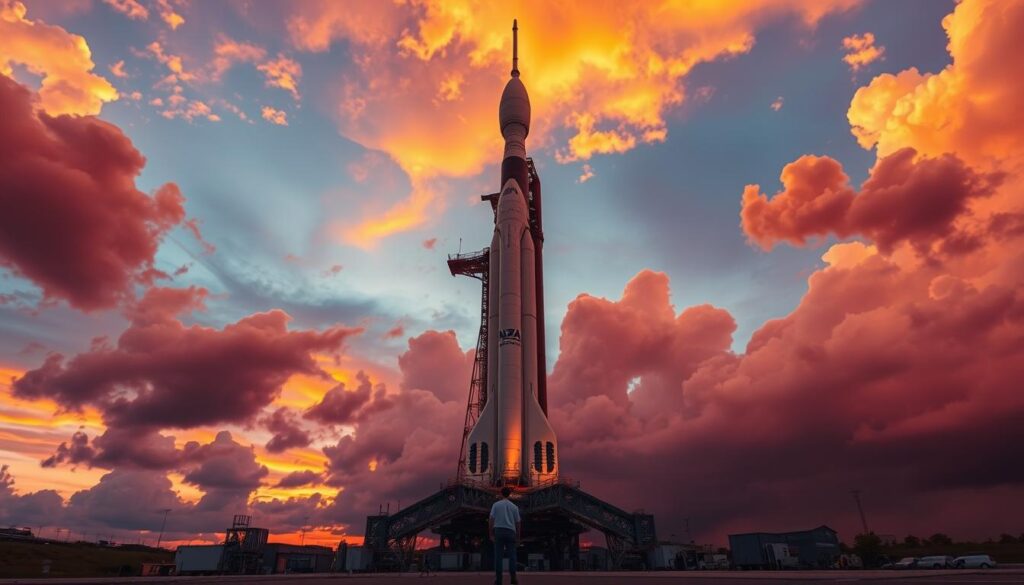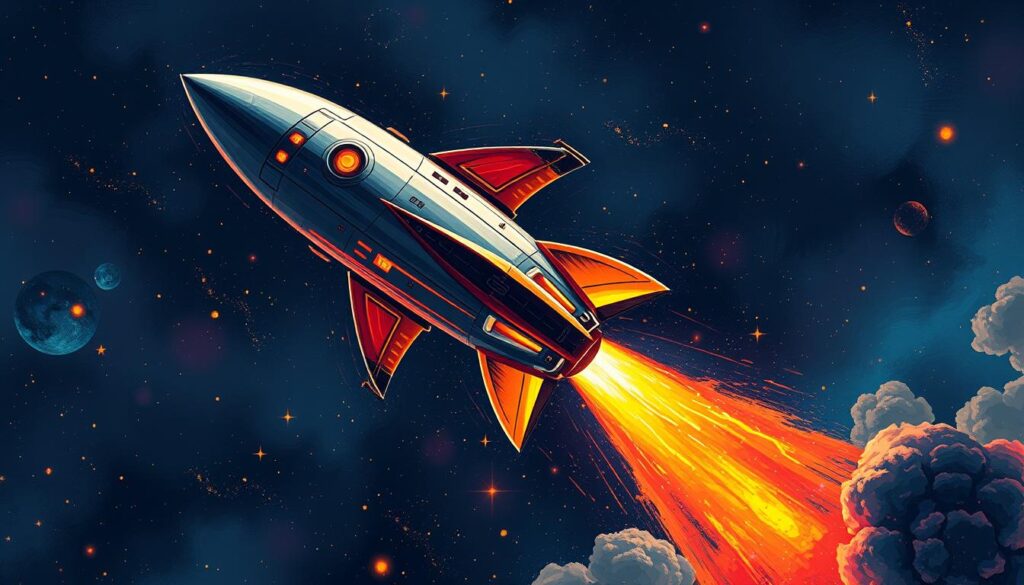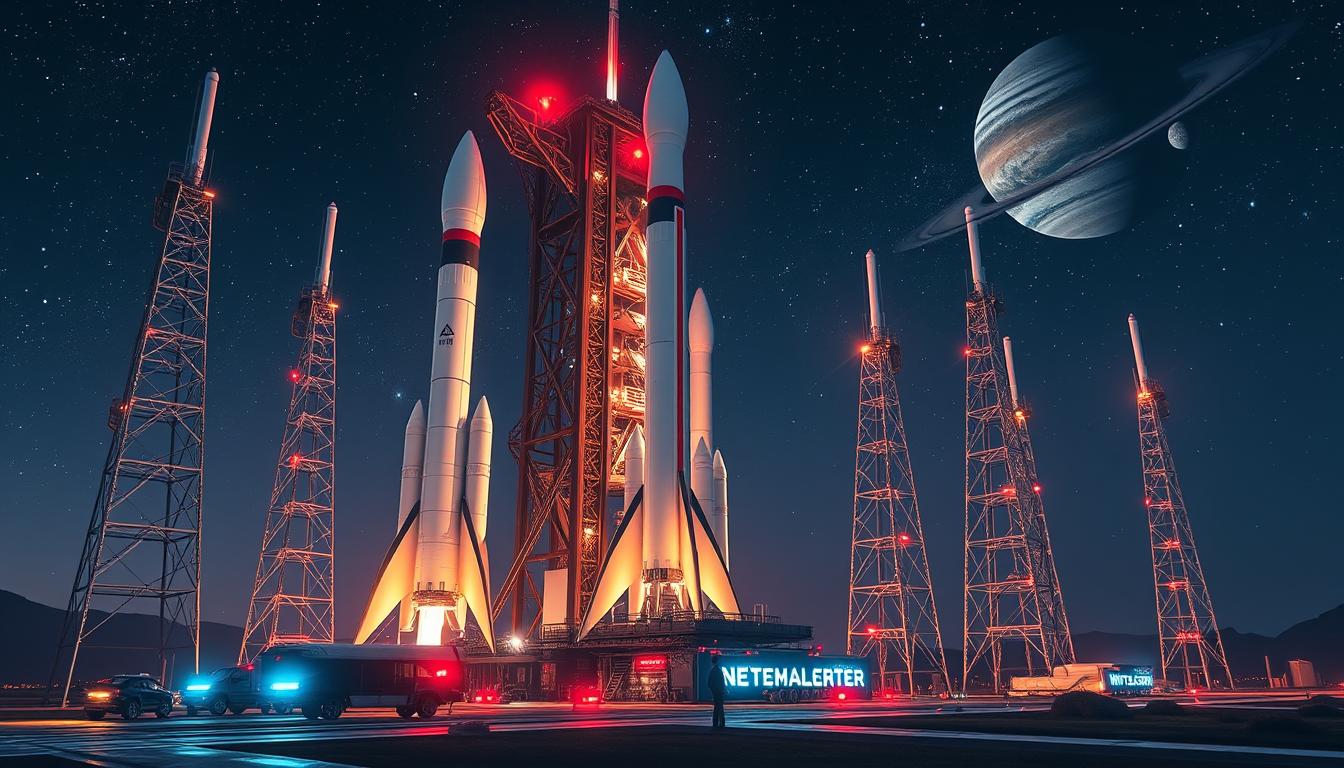“As an Amazon Associate I earn from qualifying purchases.” .
Looking up at the night sky fills us with wonder. The vastness of space has always sparked our imagination. Now, thanks to advanced Space Launch Systems, we’re closer to exploring it. These rockets are changing aerospace engineering, starting a new era of exploration.
The dream of space travel is no longer just a dream. With each new breakthrough in Space Launch Systems, we’re making history. From the powerful SLS to reusable rockets, these technologies are our keys to the cosmos. They promise adventures that were once only in science fiction.
Let’s dive into these next-generation rockets. We’ll see how they’re changing space travel. They’re making the impossible possible and bringing us closer to the stars. The future of space exploration is here, and it’s thrilling.
Key Takeaways
- Space Launch Systems are revolutionizing our ability to explore beyond Earth
- Next-gen rockets offer unprecedented power and payload capacity
- Advancements in rocket propulsion are key to deep space missions
- Reusable launch systems are making space more accessible
- Aerospace engineering innovations are driving the future of space travel
- SLS is NASA’s most powerful rocket for lunar and Mars missions
- Emerging technologies are dramatically reducing launch costs
The Evolution of Space Launch Systems
Since Sputnik 1 launched in 1957, space exploration has made huge strides. We’ve seen big improvements in spacecraft design and how they move in space. These advances have led to amazing missions.
From Saturn V to SLS: A Historical Perspective
The Saturn V rocket was key in the Apollo missions. Now, NASA’s Space Launch System (SLS) is taking us even further. The SLS can carry more payload to deep space than any rocket before it. This shows how much we’ve improved in rocket technology.
Key Milestones in Rocket Development
Space exploration has hit many important milestones:
- 1961: Yuri Gagarin becomes the first human to orbit Earth
- 1969-1972: Six Apollo missions explore the Moon
- 1980s: Space Shuttle era begins
- 2000: International Space Station continuous occupation starts
The Need for Next-Generation Launch Vehicles
For missions to the Moon and Mars, we need next-generation launch vehicles like SLS. These rockets are pushing the limits of space travel. They let us carry more payload and go farther into space.
| SLS Variant | Payload Capacity to Deep Space |
|---|---|
| Block 1 | 27 metric tons |
| Block 1B | 38 metric tons |
| Block 2 | 46 metric tons |
The SLS is set to be crucial for future space missions. It will help us explore space like never before, pushing the limits of spacecraft design and orbital mechanics.
NASA’s Space Launch System (SLS): America’s Rocket

We’re excited to introduce NASA’s Space Launch System (SLS), the most powerful rocket in America. It’s set to change space exploration, taking us beyond the Moon and into deep space.
The SLS is a true engineering wonder. It’s made for carrying heavy payloads and efficient launches. The Block 1 version can send 27 metric tons to orbits beyond the Moon. Future versions will do even more.
Here are some key features of the SLS:
- Block 1B crew vehicle can carry up to 38 metric tons to deep space
- Block 2 design aims to lift over 46 metric tons to deep space
- Generates 8.8 million pounds of maximum thrust during launch
- Four RS-25 engines provide about 2 million pounds of thrust
The SLS shows American innovation and teamwork. Over 1,100 companies across the U.S. helped make it happen. This shows our nation’s tech skills.
“The SLS is not just a rocket; it’s America’s gateway to the stars.”
This rocket is more than just powerful. It’s a new chapter in space exploration. It will take humans back to the Moon and maybe even to Mars. The SLS will carry our dreams to the stars.
Artemis Program: Returning Humans to the Moon
The Artemis program is starting a new chapter in space exploration. We aim to send humans back to the Moon and make a lasting presence there. This big project combines advanced Mission Planning with new Spacecraft Design to explore space like never before.
Artemis Missions Overview
Artemis I was an uncrewed test flight that opened the door for more missions. It went 450,000 km to the Moon, flying just 130 km above it. The mission lasted 25.5 days before landing in the Pacific Ocean near California.
| Mission | Type | Planned Launch |
|---|---|---|
| Artemis II | Crewed flight test | September 2025 |
| Artemis III | First human lunar exploration | September 2026 |
| Artemis IV | Continued exploration | 2027 |
| Artemis V | Advanced exploration | 2029 |
SLS’s Role in Lunar Exploration
The Space Launch System (SLS) is key to our lunar goals. It’s as tall as the Statue of Liberty and 15% more powerful than the Saturn V. This engineering wonder will carry both crew and cargo, helping us explore deep space.
Preparing for Mars and Beyond
Our Moon missions are just the start. We’re using the Moon to test technologies for Mars and beyond. The VIPER rover will search for water on the Moon in 2024, setting the stage for future resource use. This mission shows our dedication to Spacecraft Design and Mission Planning.
The Moon is a 4.5-billion-year-old time capsule, providing valuable information about the Earth and the solar system’s history and formation.
With 43 countries supporting the Artemis Accords, we’re working together for a peaceful, prosperous space future. Our journey to the stars is starting, and we’re excited to see where it takes us.
SLS Design and Capabilities
We’re starting a new chapter in space exploration with NASA’s Space Launch System (SLS). This rocket is the most powerful ever made by NASA. It shows our dedication to advancing spacecraft design and exploring deep space.
The SLS is truly massive. It stands at 98 meters tall for Block 1 and 111 meters for Block 1B/2. It has a core stage with four RS-25 engines and two solid rocket boosters. Together, they produce an incredible 39 MN of thrust.

- Payload to Low Earth Orbit: 95,000 kg
- Payload to Translunar Injection: 42,000 kg (Block 1B)
- Total mass: 2,610,000 kg
The SLS can be customized for different missions. It’s ready for everything from lunar landings to trips to Mars. This rocket is set to expand our reach in the universe.
“The SLS is designed to have the capability to launch more payload mass and volume than any other space rocket ever developed.”
The SLS’s design is flexible, opening up new possibilities for missions. It’s not just about the Moon; it’s about exploring further than ever before. Each launch is a step forward in the story of space travel.
| Component | Height | Diameter | Mass | Thrust |
|---|---|---|---|---|
| Core Stage | 98 m (Block 1) | 8.4 m | – | – |
| Solid Rocket Boosters | 54 m | 3.7 m | 730,000 kg | 32 MN |
| Second Stage (Block 1B/2) | – | – | – | 433.1 kN |
Rocket Propulsion Technologies in SLS
We’re exploring the advanced technologies of the Space Launch System (SLS). This rocket is a giant leap in space exploration, thanks to its cutting-edge propulsion.
Core Stage Engines
The SLS core stage is a giant, with four RS-25 engines. These engines produce over 2 million pounds of thrust each, running at 109% power. It’s like having 160,000 Corvette engines working together!
Solid Rocket Boosters
Two solid rocket boosters sit beside the core, each adding 3.6 million pounds of thrust. Northrop Grumman updated these from the old Space Shuttle days, adding a fifth segment for more power. They make up 75% of the SLS’s initial thrust.
Upper Stage Propulsion
Once in space, the Interim Cryogenic Propulsion Stage (ICPS) takes over. This is a modified Delta IV second stage designed for precise payload delivery to deep space. It’s key for our missions to the Moon and beyond.
The SLS can lift 70 tonnes at first, growing to 130 tonnes. This rocket is more than just powerful. It’s a symbol of American innovation, creating jobs and pushing aerospace engineering limits.
Launch Vehicle Integration and Assembly
We’re in an exciting time for space exploration, thanks to launch vehicle integration. NASA’s teams across the country work together to bring the Space Launch System (SLS) to life. The journey starts at the Michoud Assembly Facility in New Orleans, where the core stage is built.
Next, we head to Kennedy Space Center in Florida. The Vehicle Assembly Building (VAB) is where the action happens. Engineers with great skill put the SLS parts together. They work with precision, making sure every bolt and wire is in the right place.
Putting the launch vehicle together is a big task. It needs careful planning and teamwork. Every part, from the solid rocket boosters to the upper stage, must fit perfectly. This requires top-level skills in aerospace engineering.
“Launch vehicle integration is the backbone of our space program. It’s where dreams of exploration become reality.”
Here are some interesting facts about spacecraft launches:
| Fact | Percentage |
|---|---|
| SmallSats (mass | 96% |
| Spacecraft with mass | 25% |
| Spacecraft | 40% |
These stats show us how small satellites are becoming more common. This brings new challenges and chances for launch vehicle integration. As we explore space more, our focus on precision and innovation in aerospace engineering gets even stronger.
Payload Deployment and Mission Flexibility
The Space Launch System (SLS) is a game-changer for sending payloads beyond Earth’s orbit. It’s a next-generation rocket that opens new doors in space exploration and scientific discovery.
Orion Spacecraft Integration
SLS is built to carry the Orion spacecraft, a crucial part of NASA’s deep space plans. Together, SLS and Orion make a strong team for crewed missions to the Moon and beyond.
Scientific Payload Capabilities
SLS has a huge payload capacity for scientific missions. The Block 1 version can send at least 26 metric tons to the Moon’s vicinity. Future versions will be even more powerful. This means we can send bigger, more complex scientific tools to deep space.
Deep Space Exploration Potential
The power of SLS makes it perfect for planning deep space missions. It can send big payloads straight to the Moon, Jupiter, Saturn, and other distant places. This opens up new ways to explore our solar system.
SLS also lets smaller satellites hitch a ride to deep space. The Orion Stage Adapter can hold 17 spots for small satellites. This gives smaller scientific missions a chance to reach space.
“SLS will provide the United States with guaranteed access to deep space and an unparalleled capability for launching primary and co-manifested payloads beyond Earth’s orbit.”
Looking ahead, SLS is ready to take space exploration to new heights. It will enable ambitious missions and help us learn more about the universe.
Reusable Launch Systems: The Future of Space Access
We’re seeing a big change in space exploration. Reusable launch systems are making space travel cheaper and more accessible. They’re changing how spacecraft are made and cutting costs a lot.
SpaceX started this change in 2011 with their reusable launch system. By 2015, they landed and recovered a rocket for the first time. This was a big step forward.
By 2017, SpaceX was flying the same rocket again. This made space travel cheaper and more reliable.
- Over $500 billion forecasted global investment in space from 1998 to 2000
- $100 billion+ invested in space in the United States alone
- 500 U.S. companies directly involved in space activities
- 27 states pursuing licensed commercial spaceports
Reusable launch systems are making a big impact. They’re not just cutting costs; they’re changing how spacecraft are made. The aim is to make going to space 10-100 times cheaper.
Reusable launch systems are the key to unlocking the full potential of space exploration.
The future of space looks bright. With new tech in reusable launch systems and spacecraft design, we’re starting a new chapter in space exploration. The sky is just the beginning.
| Milestone | Year | Significance |
|---|---|---|
| SpaceX reusable program start | 2011 | Pioneering reusable technology |
| First successful landing | 2015 | Proof of concept |
| Routine reflights begin | 2017 | Commercial viability established |
| First 10-mission booster | 2021 | Demonstrating long-term reusability |
Space Launch Systems: Global Competition and Collaboration
The race to space has brought both fierce competition and amazing teamwork in aerospace engineering. Countries and private companies are pouring resources into rocket technology. This has led to a big change in how we plan missions and explore space.
SpaceX has changed the game, making up 87% of Earth’s space cargo in 2023 with its Falcon rockets. They’ve made space travel cheaper, offering launches to low Earth orbit for $56.5 million in 2013. This was much cheaper than others.
This competition has driven new ideas. NASA is working with seven U.S. companies through the Collaborations for Commercial Space Capabilities-2. The aim is to create a busy market in low Earth orbit where NASA is just one customer.
Working together across borders is key in aerospace engineering. A study from 2013-2015 showed that most scientists believe international partnerships are essential. This teamwork is seen in many scientific papers, with most coming from projects with other countries.
As we explore space further, the mix of competition and teamwork will be crucial. It’s not just about reaching for the stars. It’s about working together to understand our universe better.
Environmental Considerations and Sustainability in Rocket Design
As we explore space, we must protect Earth and space. Rocket launches jumped from 104 in 2020 to 133 in 2021. This shows we need sustainable spacecraft design. We must balance our desire to explore space with caring for our planet.
Eco-Friendly Propellants
Rockets affect our atmosphere a lot. They release substances that warm the stratosphere. We’re looking at green propellants to lessen this harm. Our aim is to make space travel less harmful, like reducing the carbon emissions of a flight from Los Angeles to London.
Reducing Space Debris
More satellites mean more space junk. SpaceX has sent over 2,000 Starlink satellites, and Amazon plans thousands more. We’re tackling this with missions like Astroscale’s 2024 project to clean up space. This will make orbits safer for future space travel.
Sustainable Manufacturing Practices
The space industry is going green. We’re using eco-friendly production methods and materials. This reduces the harm caused by making rockets. By doing this, we’re exploring space responsibly.
FAQ
What is the Space Launch System (SLS)?
How does SLS compare to the historic Saturn V rocket?
What is the role of SLS in NASA’s Artemis program?
What are the key design features and capabilities of SLS?
What advanced rocket propulsion technologies does SLS utilize?
How does the integration and assembly of SLS take place?
What payload deployment capabilities does SLS offer?
Is SLS designed to be a reusable launch system?
What is the global competition and collaboration landscape for space launch systems?
How are environmental considerations and sustainability addressed in rocket design?
“As an Amazon Associate I earn from qualifying purchases.” .



